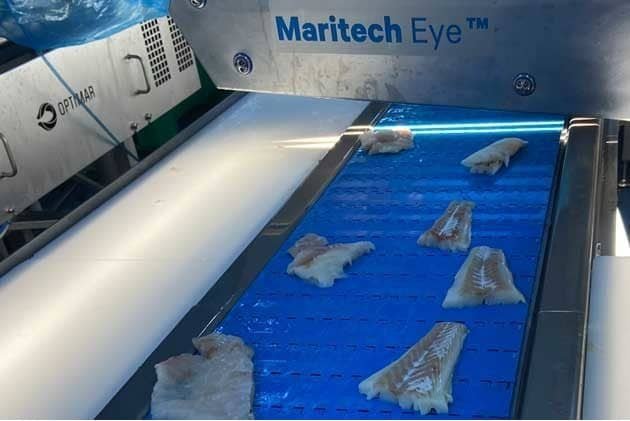
The seafood industry faces a constant challenge: the presence of parasites in fish muscle. These microscopic invaders not only compromise the quality of seafood products but also pose significant health risks to consumers. Traditional methods for detecting these parasites, such as manual inspection, are time-consuming, labor-intensive, and often ineffective.
To address this challenge, researchers at Nofima and The Arctic University of Norway have developed an innovative solution that harnesses the power of artificial intelligence (AI). By combining deep neural networks with hyperspectral imaging, this technology offers a fast, non-invasive, and highly accurate method for detecting parasites.
The Problem
Parasites in fish are a major problem for fish producers worldwide, as they present both quality and health issues.
In the case of Atlantic cod, there are two main species of nematodes that infest the fish: Pseudoterranova decipiens and Anisakis simplex. These parasitic nematodes not only compromise the quality of fish products, but they can also cause health issues in humans if consumed raw or undercooked, including intestinal anisakiasis and potentially life-threatening allergic reactions.
Limitations of Traditional Methods
The traditional method of manual examination using a lighted table, or candling table, is time-consuming and resource-intensive, often representing up to 50% of production costs. Furthermore, this method is subjective and only detects about 50% of nematodes. This limitation not only affects the quality of seafood products but also has implications for public health.
Developing an automated technology capable of detecting nematodes in seafood would provide significant benefits in terms of improved safety and product quality and reduced labor costs.
Hyperspectral Imaging
Hyperspectral imaging has long been investigated as a potential method for detecting nematodes in seafood. This technology measures numerous wavelengths of light in each pixel, providing highly detailed information in both spectral and spatial dimensions. The spectrum of each pixel provides information about the chemical and physical structure of the sample at that location.
Hyperspectral imaging is a non-invasive technique that captures detailed information about the spatial and spectral characteristics of fish tissue. By analyzing this data, deep neural networks can identify subtle differences between parasites and fish tissue, enabling accurate detection.
Stay Always Informed
Join our communities to instantly receive the most important news, reports, and analysis from the aquaculture industry.
How It Works
Hyperspectral imaging captures detailed spectral information over a wide range of wavelengths, providing a rich dataset for analysis. Deep neural networks, a type of artificial intelligence, are trained with this data to learn to recognize the unique spectral signatures of parasites. By analyzing both spatial and spectral information, the AI system can identify parasites with high accuracy.
Benefits of the New Technology
- Improved Detection Rates: The AI-powered system significantly outperforms traditional manual inspection, achieving detection rates of up to 73% compared to 50%.
- Fast and Non-Invasive: The technology can be integrated directly into existing industrial processing lines, enabling rapid and continuous monitoring of seafood products without the need for destructive testing.
- Enhanced Food Safety: By effectively detecting and removing contaminated fish, this technology helps ensure the safety and quality of seafood products.
Implications for the Fish Processing Industry
The new technology has the potential to revolutionize the seafood processing industry by providing a fast and reliable method for detecting parasites. This is especially important for ensuring consumer health and safety, as parasites can pose a risk to human health if not detected and properly removed.
The benefits of this technology go beyond improved detection rates. The hyperspectral imaging system can be easily integrated into existing processing lines, reducing the need for manual inspection and minimizing contamination risk. This can also help reduce waste and improve the overall efficiency of the production process.
Conclusion
The development of AI-driven parasite detection represents a significant advancement in the field of food safety. By automating the detection process, this technology has the potential to revolutionize the seafood industry, protecting consumers and improving the overall quality of seafood products. As AI continues to evolve, we can expect even more innovative solutions to address the challenges faced by the food industry.
The study was funded by Nofima.
Contact
Kathryn E. Anderssen
Department of Seafood Industry, Nofima AS
P.O. Box 6122, 9291, Tromsö, Norway
Email: kate.anderssen@nofima.no
Reference (open access)
Syed, S., Ortega, S., Anderssen, K. E., Nilsen, H. A., & Heia, K. (2024). Hyperspectral imaging and deep learning for parasite detection in white fish under industrial conditions. Scientific Reports, 14(1), 1-14. https://doi.org/10.1038/s41598-024-76808-w
Editor at the digital magazine AquaHoy. He holds a degree in Aquaculture Biology from the National University of Santa (UNS) and a Master’s degree in Science and Innovation Management from the Polytechnic University of Valencia, with postgraduate diplomas in Business Innovation and Innovation Management. He possesses extensive experience in the aquaculture and fisheries sector, having led the Fisheries Innovation Unit of the National Program for Innovation in Fisheries and Aquaculture (PNIPA). He has served as a senior consultant in technology watch, an innovation project formulator and advisor, and a lecturer at UNS. He is a member of the Peruvian College of Biologists and was recognized by the World Aquaculture Society (WAS) in 2016 for his contribution to aquaculture.




